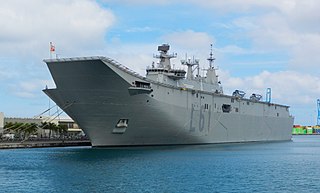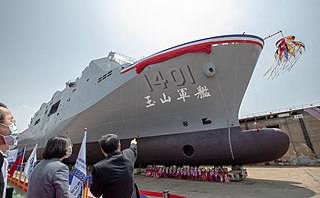
An aircraft carrier is a warship that serves as a seagoing airbase, equipped with a full-length flight deck and facilities for carrying, arming, deploying, and recovering aircraft. Typically, it is the capital ship of a fleet, as it allows a naval force to project air power worldwide without depending on local bases for staging aircraft operations. Carriers have evolved since their inception in the early twentieth century from wooden vessels used to deploy balloons to nuclear-powered warships that carry numerous fighters, strike aircraft, helicopters, and other types of aircraft. While heavier aircraft such as fixed-wing gunships and bombers have been launched from aircraft carriers, it is currently not possible to land them. By its diplomatic and tactical power, its mobility, its autonomy and the variety of its means, the aircraft carrier is often the centerpiece of modern combat fleets. Tactically or even strategically, it replaced the battleship in the role of flagship of a fleet. One of its great advantages is that, by sailing in international waters, it does not interfere with any territorial sovereignty and thus obviates the need for overflight authorizations from third-party countries, reduces the times and transit distances of aircraft and therefore significantly increase the time of availability on the combat zone.

The Albion-class landing platform dock is a class of amphibious warfare ship in service with the Royal Navy. The class consists of two vessels, HMS Albion and HMS Bulwark, ordered in 1996 to replace the ageing Fearless class. Both ships were built by BAE Systems Marine at the former Vickers Shipbuilding and Engineering yard in Barrow-in-Furness. Albion was commissioned in 2003 and Bulwark in 2004. Each of the ships has a crew of 325 and can accommodate up to 405 troops. Thirty-one large trucks and thirty-six smaller vehicles and main battle tanks can be carried inside the vehicle deck. To disembark troops and vehicles, the vessels are equipped with eight landing craft.

Juan Carlos I is a multi-purpose amphibious assault ship-aircraft carrier in the Spanish Navy. Similar in role to many aircraft carriers, the ship has a ski jump for STOVL operations, and is equipped with the AV-8B Harrier II attack aircraft or the new F-35B fighter aircraft. The vessel is named in honour of Juan Carlos I, the former King of Spain.

The Canberra class is a ship class of two landing helicopter dock (LHD) ships built for the Royal Australian Navy (RAN). Planning to upgrade the navy's amphibious fleet began in 2000, based on Australian experiences leading the International Force for East Timor peacekeeping operation. With a new climate for growing Australian Navy spending, a desire existed for forward defence capability for landing and supporting troops on Asian territory, that had never existed in Australian history, even with the old Majestic-class light fleet carriers, HMAS Melbourne and HMAS Sydney in the 1970s. In 2004, French company Direction des Constructions Navales (DCN) and Spanish company Navantia were invited to tender proposals, with DCN offering the Mistral-class amphibious assault ship and Navantia proposing the "Buque de Proyección Estratégica" design. The Spanish design was selected in 2007, with Navantia responsible for construction of the ships from the keel to the flight deck, and BAE Systems Australia handling the fabrication of the combat and communications systems. Finally, Siemens (Germany) supplied and fitted the azimuth thrusters.

Mazagon Dock Shipbuilders Limited (MDL), formerly called Mazagon Dock Limited, is a shipyard situated in Mazagaon, Mumbai. It manufactures warships and submarines for the Indian Navy and offshore platforms and associated support vessels for offshore oil drilling. It also builds tankers, cargo bulk carriers, passenger ships and ferries.

The Endurance-class tank landing ships (LST) are the largest class of ships in the Republic of Singapore Navy (RSN). They were designed and built by Singapore Technologies (ST) Marine to replace the old County-class tank landing ships. The four ships form the Third Flotilla of the RSN.

Goa Shipyard Limited (GSL) is an Indian Government owned ship building company located on the West Coast of India at Vasco da Gama, Goa. It was established in 1957, originally by the colonial government of the Portuguese in India as the "Estaleiros Navais de Goa", to build barges to be used in Goa's growing mining industry, which took off after the establishment of India's blockade of Goa in 1955. In the wake of Portugal's defeat and unconditional surrender to India following the 1961 Indian annexation of Goa, it was requisitioned to manufacture warships for the Indian Navy and the Indian Coast Guard.

INS Jalashwa is an amphibious transport dock currently in service with the Indian Navy. Formerly USS Trenton, she, along with six Sikorsky SH-3 Sea King helicopters were procured from the United States by India for a total of US$90 million in 2005. She was commissioned on 22 June 2007. INS Jalashwa is the only Indian naval ship to be acquired from the United States. She is based in Visakhapatnam under the Eastern Naval Command.

The San Giorgio class are amphibious transport docks (LPD) built by Fincantieri for the Italian Navy. These ships can carry a battalion of troops, and up to 36 armored vehicles. The stern floodable dock can accommodate three landing craft. The ships are based at the Brindisi naval base on the Adriatic coast.

The Nilgiri-class frigate or Project 17A is a follow-on of the Project 17 Shivalik-class frigate for the Indian Navy. A total of seven ships will be built at Mazagon Dock and GRSE.

HMAS Canberra (L02) is the first ship of the Canberra-class landing helicopter dock in service with the Royal Australian Navy (RAN) and is the second largest in the Navy, succeeded by its sister ship HMAS Adelaide (L01). Construction of the ship started in Spain in 2008, with the hull launched by Navantia in 2011. The hull was then transported to Australia in late 2012 for completion by BAE Systems Australia. Canberra was commissioned on 28 November 2014.

INS Shakti (A57) is a Deepak-class fleet tanker in service with the Indian Navy. She was built by Fincantieri, an Italian shipbuilding company based in Trieste. She is the second and final ship of her class. Shakti, along with her predecessor Deepak, is one of the largest ships of the Indian Navy.

The Indian Navy has been focusing on developing indigenous platforms, systems, sensors and weapons as part of the nation's modernisation and expansion of its maritime forces. As of 2020 the Indian Navy has 43 vessels of various types under construction, including an aircraft carrier; destroyers; frigates; corvettes; and conventional-powered and nuclear-powered submarines and plans to build a strong navy of 200 vessels and 500 aircraft by 2050. In 2013 a senior naval official outlined the Indian Navy's intention to build a 200 ship navy over a 10-year period. According to Chief of Naval Staff's statement in December 2020, India has transformed from a buyer's navy to a builder's navy. All 41 ships under construction are being produced in Indian shipyards, both publicly and privately owned. However some projects have suffered from long delays and cost overruns.

Kalaat Beni Abbes (L-474) is an amphibious transport dockof the Algerian National Navy. The ship built by the Italian firm Fincantieri as an enlarged and improved version of the San Giorgio class. The ship measures 143 metres (469 ft) long and 21.5 metres (71 ft) wide.

TCG Anadolu (L-400) is an amphibious assault ship (LHD) of the Turkish Navy that can be configured as a light aircraft carrier. It is named after the peninsula of Anatolia which forms the majority of the land mass of Turkey. The construction works began on 30 April 2016 at the shipyard of Sedef Shipbuilding Inc. in Istanbul, with the keel being laid 7 February 2018, and is expected to be commissioned in 2022. The vessel is intended to meet the various needs and requirements of the Turkish Armed Forces, such as sustaining long-endurance, long-distance military combat or humanitarian relief operations; while acting as a command center and flagship for the Turkish Navy. It is claimed to be the first aircraft carrier to launch Unmanned combat aerial vehicle (UCAV)

The Yushan-class landing platform dock is a class of landing platform dock built by CSBC Corporation, Taiwan for the Republic of China Navy (ROCN). Four ships were planned, with one ship launched in April 2021.

















